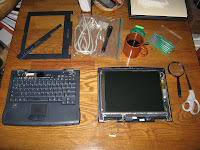Next was to decide how to make the
wired connections from the base to the display. I wanted to avoid
hardwiring if possible to facilitate transport if needed, and it was
clear from the service manual that the base and display were joined
by a plug and socket connection. While the part numbers naturally
weren't identified, I had the urge to make a cable that could be
directly joined with the existing connectors. That would require
tracking down the correct connectors.
I carefully examined the connectors
after detaching the display from the base, which went fairly smoothly
according to the directions in the service manual. Digging through
part sites while paying particular attention to connector shapes
finally turned up the necessary parts: SHD Connectors manufactured by
JST. The parts were easily verified by comparing various dimensional
measurements of the parts on the laptop to the part dimensions noted
on the parts' spec sheets.
With the parts found, it turned out
that a specialized hand tool was needed to properly make the
electrical connections to the plug... And it cost, like, $1000! As
that was just a bit outside my budget, I considered making the needed
crimp connections using a pair of really
small needle nose pliers. But that'd be a pain. And who wants to take on that level
of tedium?
 The
connection was wired rather than being a flexible plastic circuit,
so the decision was finally made to just wire in some other readily
available connectors and use a readily available cable. The number of
wires in the connection, the available space in the laptop display,
and the stack of unused cables in my junk closet led to the choice...
Parallel printer connectors. I cut off the plug from the display and
was ready to go.
The
connection was wired rather than being a flexible plastic circuit,
so the decision was finally made to just wire in some other readily
available connectors and use a readily available cable. The number of
wires in the connection, the available space in the laptop display,
and the stack of unused cables in my junk closet led to the choice...
Parallel printer connectors. I cut off the plug from the display and
was ready to go.  |
| Yes, it's backward. |
Then I noticed my
mistake... The connections needed to be made to the female connector rather than
to the male connector shown in the pinout diagram. Fortunately, this was
a minor bump in the road. A couple of mild oaths and a bit of image
processing later, I had an inverted image from which to work. Careful soldering to make the actual connections finished the initial work at the display end.
 While it felt good
to complete this first bit, a worry hung over the project... Would
transmission line effects over a six-foot (182-cm) cable muck up the display?
Would I need to put in extra impedance matching circuits? Instead of
doing the wise thing and calculating it out, which would've required recalling forgotten
college stuff from way back before the turn of the century, I had already decided
to just try it. But I'd have to wait until the base connection was
complete before seeing what would happen...
While it felt good
to complete this first bit, a worry hung over the project... Would
transmission line effects over a six-foot (182-cm) cable muck up the display?
Would I need to put in extra impedance matching circuits? Instead of
doing the wise thing and calculating it out, which would've required recalling forgotten
college stuff from way back before the turn of the century, I had already decided
to just try it. But I'd have to wait until the base connection was
complete before seeing what would happen...